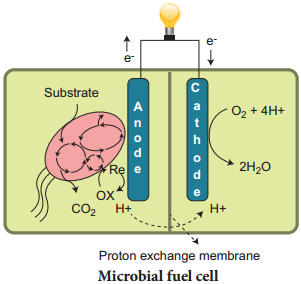Learninsta presents the core concepts of Biology with high-quality research papers and topical review articles.
Microbes In Sewage Treatment And Energy Generation
Sewage is the waste generated every day in cities and towns containing human excreta. It contains large amounts of organic matter and microbes, which are pathogenic to humans and are bio-degradable pollutants. Domestic waste consists of approximately 99 percent water, suspended solids and other soluble organic and inorganic substances. Sewage should not be discharged directly into natural water bodies like rivers and streams. Before disposal, sewage should be treated in sewage treatment plants to make it less polluting.
Microbes (mass of bacteria floc) are allowed to grow in aerated water (secondary treatment). They consume major part of organic matter in the effluent and reduce the BOD in the waste water (The details on waste water treatment are discussed in chapter 12).
Microbial fuel cell (MFC)
A microbial fuel cell is a bio-electrochemical system that drives an electric current by using bacteria and mimicking bacterial interaction found in nature (Fig. 8.2). Microbial fuel cells work by allowing bacteria to oxidize and reduce organic molecules.
Bacterial respiration is basically one big redox reaction in which electrons are being moved around. A MFC consists of an anode and a cathode separated by a proton exchange membrane. Microbes at the anode oxidize the organic fuel generating protons which pass through the membrane to the cathode and the electrons pass through the anode to the external circuit to generate current.
